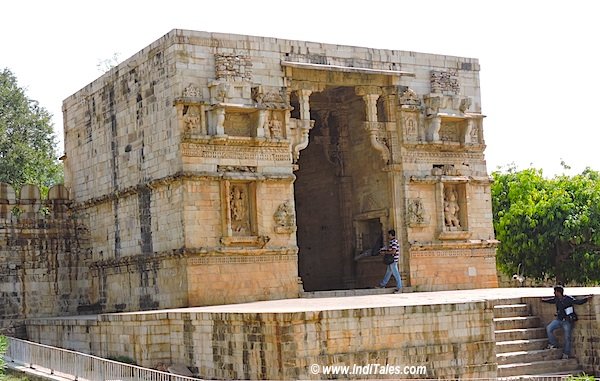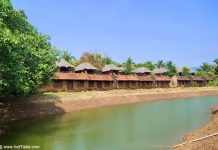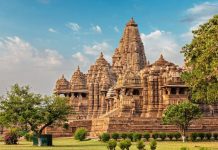If there is one fort in India that I clearly remember from my history books, it is the Chittorgarh Fort. Also called Chittaurgarh Fort. So many important characters of Indian history have lived here. That I met them in history books when it came to kings like Maharana Pratap and Rana Sangha. I met them in poetry books when it came to Mira Bai. Met them in historical fiction like Cuckold by Kiran Nagarkar. I heard about the Jauhar of Rani Padmini in numerous stories and works of fiction it inspired. It appeared as a whole star cast of a grand production lived in Chittorgarh.

Of course over a period of a few hundred years, but when seen through the lens of the present they all seem to merge in one time – history.
Chittorgarh Fort History
In fact, while I was there I found out that the roots of this mighty fort go back to 7th CE. When the Mauryan King Chitrangada Mori built it, the fort derived its name from his name. By 8th CE it passed on to the Sisodias of Mewar who would rule from here for the next 800 years. Till they were forced to establish their new capital at Udaipur. It continues to be a living fort with many villages inside it still calling it home. Can you just imagine the number of stories these walls and people have to tell?

Elongated fish-shaped Chittorgarh is also one of the largest forts in India so it is not easy to see it in one day. There is a heritage area that most tourists visit, and there is a village area. There is a dense forest area and the fort is dotted with many water bodies.
Chittorgarh Fort Visit – What You Must Know
I spent one full day walking around the fort. And finishing the day by watching the famous light and sound show here. A popular circuit that a guide usually takes the tourists around and can be done in probably 2-3 hours. But if you look at leisure, there is much more to explore. Chittorgarh is one of the 5 hill forts of Rajasthan that are a UNESCO World Heritage site. Others are Kumbhalgarh, Sonar Qila Jaisalmer, Amber Fort & Ranthambore Fort.
Kumbha Mahal

This is the core of Chittorgarh fort – the main palace area where the royal families lived. Interestingly there is only one main palace where the royal family lived, divided into male and female sections.
The walls of Kumbha Mahal are in a threadbare state – they look extremely fragile, especially with large windows that make you see across the wall. With a faint hint of decorations on the walls. You almost fear that some of them may fall if you stand against them or shake them a bit. To me, it is probably a depiction of the state of walls, as they exist today. Exhausted after years of living, after having seen so much violence and so many generations. Jharokhas are just hanging on to the bare walls as if they have been pasted or projected there.
Kumbha Mahal is the oldest part of the fort and besides living quarters, you can see the remains of the Shiva temple. This is the palace where the Rani Padmini, Rani Karnavati, Mira Bai & Panna Dhai lived. Apparently, there is an underground passage from the ladies’ chamber here that goes to the nearby pond. It was meant for women to reach the bathing area without being seen. This place comes alive in the evening when light and sound show uses it as a backdrop to tell the story of Mewar.
Close to the ramparts, you can see the view of Chittorgarh city and you suddenly realize it is quite a big city.
Ram Pol

Pol’s are city gates in Mewar. Chittorgarh Fort has gates called Suraj Pol, Pada Pol, Hanuman Pol, Ganesh Pol, Jodla Pol, Laxman Pol, and Ram Pol. I visited the Suraj Pol which lies in the East – the direction of the rising Sun. From here you see the vistas of Mewar from a height, with a highway going through the green fields and hills in the backdrop. Each of the gates has a story – some have seen the deaths of their princes and warriors. Some have defeated the enemy and did not let them enter the fort. Stone cenotaphs at the gates commemorate these brave men. All the gates are linked with a circular road, and each of them is a formidable stone structure that you can admire.

I spent some time at Ram Pol, which is the main gate through which you enter the fort as a tourist. The richly carved stone gate has many deities carved on it, that it seems are still worshiped actively. There are inscriptions in stone that are in Devnagari script yet a bit difficult to read as they follow a local dialect. It seems the concept of separating words was yet to become popular. The base of the gate carved with elephants almost resembles the base of a temple that stands on the back of hundreds of elephants.
Vijay Stambha or the Tower of Victory at Chittorgarh Fort, Rajasthan

The Vijay Stambha is the most celebrated monument of Chittorgarh. It is a tall pillar-like structure standing tall towering over every other structure around it. Celebrating the victory of Rana Kumbha in mid-16th CE over Sultan of Malwa. It is actually two pillars one inside the other with a narrow hollow cavity in between. The outside and inside of the Vijay Stambha are profusely carved with divine as well as royal symbols. There are many Hindu deities that are carved on the nine stories of the Stambha. And there is the sun, a symbol of the Sisodia dynasty that considers itself a descendant of the sun.
Our guide said that the nine stories of Vijay Stambha depict the nine avatars of Vishnu to whom this tower is dedicated. With all its carvings, it is also referred to as the school of Indian iconography. A unique aspect of Vijay Stambha is the portraits of its architect Jaita and his three sons Napa, Pooja & Poma carved on the 5th story. The base of the tower again sounds like the base of a temple. In fact, you have to take your shoes off to enter the tower.

Climbing Vijay Stambha
You can go up to the 8th story of the structure through 157 narrow steep steps that go up in a circular fashion. It needs a bit of endurance to go up, but then a bird’s eye view of the Chittoor is the reward you get. I went up to the 3rd story and gave up. Though I must say the carvings inside are just breathtaking. Someone should do a storytelling hike of the tower for tourists. The stairs alternatively go through the central chamber and the surrounding gallery. Architecturally, it is a wonder as the hollow structure has been so designed that it can withstand the winds. And other climatic conditions by channeling the wind through its corridor.

My guide told me that after India’s independence in 1947, Vijay Stambha was Sardar Patel’s choice for the national symbol. However, Nehru disapproved of it.
Kirti Stambh or Tower of Fame, Chittorgarh Fort, Rajasthan

This is the older of the two towers at the fort and this one is dedicated to the first Jain Teerthanker, Adinath Ji. A Jain merchant probably built it in 12th CE and it is my presumption that it would have inspired the Vijay Stambha.
You cannot enter Kirti Stambha and must admire it from the outside only. However, this one also has winding stairs that take you to the 6th story of the tower.
Jauhar Sthala

The ground between the Vijay Stambha and the Smadishwara temple is surrounded by two ornate gates. One each in South and East is Jauhar Sthala or the place where the queens of Mewar conducted Jauhar.
The first Jauhar was done by Rani Padmavati after the attack of Alauddin Khilji in 13th CE. Another was done was Rani Karnavati during the times of Akbar and a third one is also recorded in history. Each time there were thousands of women and children who jumped into the fire and immolated themselves. Choosing death over losing their honor to the invading armies.
Today it looks like plain ground filled with tourists going from one spot to another. But I was told that in those days it was a hollow cavity in which flames used to be lit and women jumped from high walls. You go through a multitude of emotions when you stand on that ground – you feel the courage of so many women to embrace the fire, and you feel sick at the circumstances that lead to such mass sacrifice. And you feel lucky that you live in the times that give you far more choices and freedom.
Padmini Palace, Chittorgarh Fort, Rajasthan

In the middle of a lake stands a multi-story structure that is popularly known as the Padmini Palace. There is another palace on the banks of the lake from where it is famed that Alauddin Khilji saw Padmini’s reflection in a mirror. As per our guide, the palace is of a later date probably 17-18th CE or so. The legend of Padmavati and Allaudin Khilji is probably a story created much later as she lived around the late 13th CE. She conducted Jauhar as a documented episode, though. At the moment this palace is in a dilapidated state and everyone visits it for being the spot of the famous story. There is nothing spectacular about it. Now that I know that the story is also fabricated it loses whatever little charm it had.
However, I do gather that this palace became the inspiration for all the Jal Mahals or Lake palaces that came up all over Rajputana later.
Fateh Prakash Palace & Museum at Chittorgarh Fort, Rajasthan

The Fateh Prakash Palace is the youngest palace built just about 100 years ago – a part of which is now a fort museum. There are some displays of ancient antiquities and some displays of painting traditions of the region. And there is some folk art on display. It is a large rectangular building with a central courtyard that proudly displays the bust of Rana Fateh Prakash.

If you are short of time you can easily skip this museum. However, if you have time visit it for the giant wooden Shiva head that is kept right at the entrance of the museum.
You need to buy a separate ticket for this museum; it is not covered by the fort ticket.
Ratan Singh Palace – Chittorgarh Fort, Rajasthan

Located across, the village is the Ratan Singh Palace next to a pond called Ratneshwar Talao. This palace is in an absolutely dilapidated state. While walking through its absolutely deserted interiors I constantly feared that some wall or some ceiling would collapse. And no one will ever find my remains. However, on the edge of the palace stands a small but exquisitely carved temple called Ratneshwar Mahadev temple.
Light & Sound Show
In the evening you can return to Kumbha palace and sit back to hear the stories of the fort – of its heroes, heroines, and villains.
Shopping & Picture Time

All through the fort, you would find stalls displaying colorful Rajasthani garments – the never-ending Ghagra’s with colorful Odhnis. There are mounds of silver jewelry to adorn the body and innumerable headgear for men to choose from. Many fellow travelers walked up to these shops to buy these garments only to figure out that they were not for sale. Well, all these stalls are photography studios. They dress you up in Rajasthani attire and click a picture for you. For Rs 50/- you can get yourself clicked in your own camera and for a print, you pay a bit extra.
There are a lot of hasta Kala Kendra’s or handicrafts shops too, and every guide would guide you towards them. Do not be trapped, you can easily skip shopping here. I was told they make Saris from custard apple, banana fiber, and sandalwood. While in my humble opinion, they were all synthetic fabrics. I was later talking to a local woman living in the village who laughed at it and asked – really they sell a Sandal Sari for Rs 400/-
If you are wondering why I have not mentioned the various temples here – wait for the next post.
Recommend you to read the following Places to visit in Rajasthan.
Nathdwara – a town that revolves around Shrinathji
Temples of Chittorgarh Fort
Royal Cenotaphs @ Bada Bagh, Jaisalmer














Bathed in intricate architecture. Nice read, Anuradha.
Thanks Niranjan. Wait for my followup post on temples of Chittorgarh.
Thanks for neat descriptions.
Happy that you enjoyed the story on Chittorgarh Sir.
Lot of interesting information which we we have not known earlier.we missed chttrgarh due to lack of time.it is my dream to visit this place. Thanks for such beautiful information friend.
Happy that you enjoyed the post on Chittorgarh. So read about other forts of India covered on Inditales.
Oh I so love this fort. It is full of legends and interesting architecture….
Absolutely Ami. I could have spent days exploring it and I admire the fact that it is still a living fort and not just a dead piece of history.
the chittirgarh still continues 2 inspire .
on my way 2 udaipur, in the gap of the connecting train time available, i had made a hurried short trip 2 the vijay stambh in scorching heat of may month.
also, my friend says as a boy of class 9th then afte c-ing the that victory tower he aspired for civil engg., and preferred that in his choice. 2dsy he is a leading architecht/ builder in a city.
good victory of passion over commerce.
Thats the beauty of great architecture, it is built by one generation but it continues to inspire many generations to come. Thanks for sharing your story Dr Karthik.
Very useful information!! And nice photographs.
Thank you Aravind. Stay connected.
Very useful information!! Nice photographs.
I love the way you compile your posts. Very well written and rich information. You can publish travel guides for regions which are well covered by you. very inspiring and lot to learn from you. Thanks !
Thank you so much VJ. Not sure if I am interested in writing travel guides – but I would rather bring out the essence of the place and then let people discover it their own way when they visit. I look at my travels as a journey into the past to be inspired for the future.
Very informative and very well written blog. Every detail about the forts has been composed precisely in a few lines, especially the photographs, are very cool. 🙂
Thanks Sandeep. Happy that you enjoyed the post.
Dear Anuradha you write so we’ll..the article and the visual treat has inspired me to be there and see for myself..
Thank you Milu for your kind words. Words like these keep me going…
Beautiful! very well written and very informative. Love your blogs very much. Read a lot about Rajasthan. Reading history works as a stress buster for me. Thank you. Keeping writing and we keep following you.
Thank you Archana. It’s feedback like this that keeps me going. Stay connected.
Very informative! And superb photos. I can only imagine the hard work that must have gone in composing this article.
Thanks Mohit. When you enjoy doing something, it feels effortless. I love travelling and specially travelling to heritage sites like Chittorgarh. Stay connected.
Thank you for the beautiful pictures and information, Anuradha! I have been trying to track down a map of Chittaurgarh with the various buildings labelled. Do you have any idea where I could find such a map? It looks like the Guide Map photo you posted may have this info, but I could not enlarge it. Any help would be greatly appreciated. 🙂
Branwen, this is the only map I found of Chittorgarh fort. Do you want me to send you a high resolution of the same?
Chittorgarh always remain my favorite destination as my elder sister lives there 🙂 so I have visited this place many times and always found it more beautiful than before . Great post
It is a fort city rather than just a fort. I am always happy to see heritage that is still living, rather than heritage that lives as ruins. I hope places like Hampi also become living sometime – hopefully in our lifetimes.
Such an amazing post on Chittorgarh Fort. I am from Rajasthan and this post added much information to my existing bucket of knowledge about the heritage of Rajasthan. Great Work. Keep It Up.